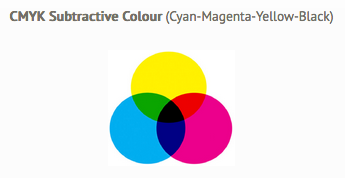Elements of Design
Additive & Subtractive Colour
Computer monitors, projectors, iPods, smart phones, television screens, etc. work much the way our eyes work. They emit red, green, and blue light and the combination of these three lights in various quantities and intensities produces the millions of colours we see on the screen.
This system of producing colours is called additive because the three primary lights (red, green, blue), are added together to form the white light.

In paint or pigment, the subtractive primary colours are red, yellow, and blue. Other colours result when primary or secondary colours are mixed.

In most colour printing, the primary ink colours use cyan, magenta, and yellow. Cyan is the complement of red, meaning that cyan acts as a filter that absorbs red. The amount of cyan applied to a paper controls how much red shows. Magenta is the complement of green, and yellow is the complement of blue. Black ink is added to the mix to obtain a real black and to give more depth to printed images. This mixture is called CMYK and is
also known as four-colour process printing. Other colours are produced by dot patterns of cyan, magenta, yellow, and/or black.
![]() The Graphic Designer's Printer
The Graphic Designer's Printer